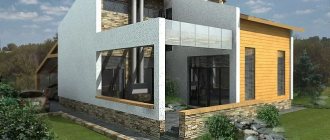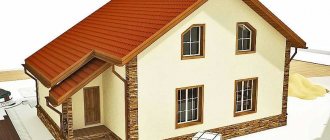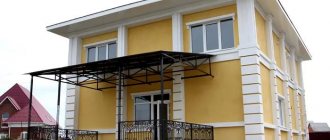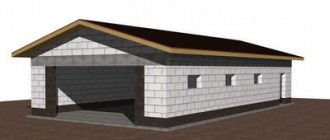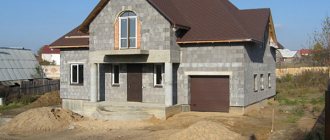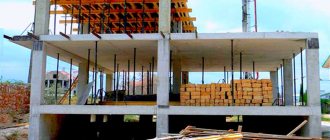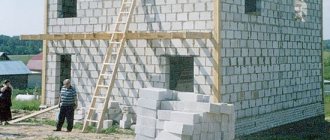If a person has to think about building his own house, then first of all he needs to decide on the choice of material for walls and ceilings, construction technology, and also select a suitable layout. If an architect can cope with any layout, then the choice of construction technology depends on your preferences and financial capabilities. If you prefer buildings made of stone, then you should pay attention to houses made of concrete panels. The main thing is not to succumb to established stereotypes, because if, in fact, the same technologies are used here as in the construction of multi-story buildings, then the qualitative methods for constructing houses have improved significantly.
Modern house made of reinforced concrete panels Source strcomfort.com
What is a modern reinforced concrete panel for the construction of a private house
Even judging by the name alone, a reinforced concrete panel is a concrete slab, inside of which there is steel reinforcement, which improves the concrete's resistance to mechanical stress and increases strength under lateral loads.
All panels are divided into three types :
- External.
- Internal interior slabs.
- Floors.
External walls can be one, two or three layers. In the latter version, the inner layer is insulation, and the outer surface of the slab is made of high-strength concrete.
Wall panels, in turn, are divided into the following types :
- Bearers.
- Self-supporting.
- Hanging slabs.
From the name it is clear that the initial ones are the basis of the building. The following panels are independent elements and they are fixed to the load-bearing walls and floors of the house.
A reinforced concrete house is assembled from slabs for various purposes, which optimizes the overall cost Source mypresentation.ru
Prefabricated frame buildings
Such country buildings and houses are assembled using a fundamentally different technology than that described above. Here, a frame is first erected (it can be metal or wood), and then the gaps in the frame are filled with some material.
What material can be used? Well, for example, in the prefabricated construction of prefabricated frame houses, developers quite often prefer to use panels. OSB (oriented strand boards) can serve as shields.
Although, the walls in such houses are not load-bearing and can, in principle, be made of any material. However, we should not forget that they must be sufficiently durable and warm. Therefore, the panels or walls themselves, after construction, contain insulation and are securely fixed to each other.
Other advantages of prefabricated frame construction include the following:
- Very fast assembly of such houses (up to two weeks);
- It can easily be carried out by 2-3 people;
- All parts are manufactured at the factory;
- The design and construction of the house can be anything;
- Low construction costs.
Advantages and disadvantages of modern panel house projects
There is no perfect way to build a home that suits everyone. Therefore, before making the final choice, you need to evaluate the advantages and disadvantages of the technology.
Advantages
As a result of regular improvement, the use of new materials and technologies, a house made of panels can be built relatively cheaply, quickly and with high quality.
For buyers of a house or cottage, 3 aspects have priority: the layout of the premises, the price per square meter and the construction period:
- Variety of design solutions . Reinforced concrete panels manufactured according to the project allow you to create buildings of various shapes, sizes and with different layouts.
Thus, panel cottages today are presented not only as economical housing, but also as houses with spacious rooms reserved for a living room, children's room, kitchen and bathroom.
Reinforced concrete houses allow you to implement almost any architectural design and can be used in both classical and modern styles Source m.shianwang.com
- Price . Prices for turnkey projects of houses made of reinforced concrete panels are significantly lower than the cost of a brick or monolithic building. Thus, the price per square meter in a panel house in the Moscow region will be from 44 to 70 thousand rubles, and in a monolithic one at the same time - from 70 to 90 thousand rubles.
- Construction speed . A house made of panels, compared to a brick one, is built several times faster. Thus, the box of a two-story house made of reinforced concrete panels, with an area of 170 sq. m., is erected in four to five days (without foundation and finishing).
This is achieved due to the fact that all panels are brought to the construction site in finished form: the external structures have openings for windows and doors, and the internal partitions have ready-made hidden channels for electrical wiring. We must not forget about the conditions for assembling a house - a monolithic one is created at the construction site, and a panel one is created at the factory.
Flaws
The disadvantages include the following parameters of the slabs:
- Soundproofing . If the house is built of one or two-layer panels, then extraneous noise from the street may be heard in such a building.
If you save on three-layer panels, then in the future you may have to spend money on sound insulation Source magnat4.ru
- Reinforced concrete surface . To attach or hang any objects on the wall, you have to use a hammer drill every time.
- Inability to change layout . The walls are not removable, so they cannot be moved.
House assembly
Concrete cottages, as a rule, are placed on a slab foundation or on a deep foundation. Manufacturers of three-layer reinforced concrete panels offer the construction of a slab 300 mm high, insulated over the entire area with a 100 mm layer of EPS (basic version). The house kit is delivered to the site by panel trucks with a carrying capacity of up to 20 tons. For example, to transport material for the construction of a two-story house, up to 10 trips may be needed. To unload and install the panels, a truck crane (25–120 tons) is required, which must be provided with access and a flat, free area of sufficient size for all manipulations. Note that transportation and operation of heavy equipment constitute a very significant expense item in the construction budget.
The walls of one floor can be installed in a day or two. First, the installed panels are fixed with supports, and then the elements are connected layer by layer to each other. Reinforcing bars are inserted into the loops embedded in the load-bearing (inner) layer of concrete and the connecting point is monolithic, creating a single prefabricated monolithic enclosing structure. In the thermal insulation circuit, the interpanel seams are filled with mineral wool or foamed, and in the outer layer of concrete they are laid with a rope of polyethylene foam and sealed with sealant. Thus, blowing or freezing of walls through the joints of panels is excluded.
The interpanel seams on the facades are only 20–25 mm thick, and if you paint them in the color of the walls, they will be almost invisible
Joining unit of two external and one internal wall panels (top view)
Connecting units in ceilings and load-bearing partitions, including corner ones, are concreted in the plane of the panels. All internal surfaces are smooth (height differences are no more than 3–5 mm) and ready for finishing; there is no need to plaster the base using reinforcing mesh, as is done in brick or block houses.
The roof can be either pitched over wooden beams or flat. The structure, based on 220 mm thick hollow core slabs with 200 mm EPS insulation, a prefabricated screed made of asbestos cement sheets (ACL) and a reinforced concrete parapet 600 mm high, is optimally “adapted” to panel technology. In addition, the flat roof fully meets modern trends in private architecture, aimed at laconic lines and simplicity of forms.
Design differences between panels
Building slabs are large-sized elements and are made from reinforced concrete in a factory.
The production of slabs occurs with the maximum degree of readiness, that is, with door and window openings. They also often arrive at the construction site with the exterior finishing completed and the interior surface prepared for wallpaper and painting.
In terms of construction, all panel houses are divided into three types :
- Panel-frame . The base and panels are single structures; in the second case, the load is shifted to the frame, and in the third, all the weight from the slabs is transferred to the panels.
- Frame . They are used in houses with complex and non-traditional structures.
- Frameless buildings . They come with load-bearing longitudinal and transverse walls.
The load-bearing external wall of a panel house is being installed Source reformtheweb.com
Advantages of frameless reinforced concrete houses :
- No oversized protruding elements inside the house.
- Easy to install.
- Savings when building a box.
Depending on the purpose and type of panel, the weight of the walls can be completely distributed over the frame of the house (hinged), accommodate only their own weight (self-supporting) and withstand the weight of the floors (load-bearing). Based on their composition, the panels can be divided into one, two and three-layer.
See also: Popular designs of houses made of reinforced concrete panels
Prefabricated buildings
They can be assembled from logs, laminated veneer lumber and other similar materials. That is, in principle, the same as those usually used in the construction of houses, with one difference - all parts are manufactured at the factory. And at the construction site all that remains is to assemble the building, like a constructor, which significantly speeds up the construction process.
In this regard, laminated veneer lumber is very good, since a house made from it practically “does not shrink” and any finishing can be done (without fear that it will crack).
It is also worth noting that the technology for manufacturing laminated veneer lumber does not stand still - today there are two fundamentally different technologies for its production (filling the “core” of the timber). We've already written about this before, so let's move on.
Build it yourself or order a turnkey service
Today, many people dream of owning their own home - this means freedom, complete isolation from noisy neighbors behind the wall, and live communication with nature in their garden.
To fulfill your desire, there are two options: build a house yourself (even with the help of hired workers) or order the work from a professional construction company. At the same time, the price of the issue at first glance seems completely different, but where you will find it and where you will lose it needs to be examined in more detail.
Building a new house yourself
It is simply impossible to build a house from reinforced concrete panels on your own, so we will simply compare the stages with the construction of an ordinary cottage.
Initially, you will have to order a house project. This is not just a layout drawing, but technical drawings that indicate the location of the house on the site, calculate the forces of the floors and other data according to which the house can be built.
You must understand that the layout and appearance are only an architectural project and it is still impossible to build a house based on these data Source pinterest.com
Next, you will have to organize the purchase and delivery of building materials. In addition, you will have to choose these materials yourself, which can be quite a difficult task for a person without construction experience.
Even now, the construction of the house has not yet begun, since many issues will need to be “sorted out,” in particular, to obtain a building permit (here, by the way, you will also need an approved project)
When the paperwork is resolved, construction can begin. Here everything depends on whether you will build completely yourself or attract additional labor. There are pitfalls here and there. If you look for workers, then the first question is their qualifications, which, let's face it, is a matter of chance. In addition, the workers will have to be constantly monitored, and since you have other things to do besides construction, it’s simply not possible to keep track of everything.
In any case - during independent construction or when involving workers, if after some time any defects appear, then you will have to correct them yourself, since the “gray” construction team will not give you any warranty obligations. And even if he does, in a year or two where will we look for these workers?
Not all builders’ shortcomings can be noticed immediately Source anayemeni.net
As a result, it is almost guaranteed that the cost of a house when erected on your own will be significantly higher even during construction, compared to the initial calculations. And this does not take into account the costs of correcting possible defects that will appear after some time (if they can be corrected at all without dismantling the house).
Turnkey construction
Even if you just go through the points listed, the difference will already be quite noticeable:
When you order, a serious construction company will make you a house design for free. In addition, this project will be read by builders without any problems, because despite standardization, even a specialist will have to understand an unfamiliar project. Plus, designing a private panel house is relatively simpler, and therefore faster.
The construction company takes care of all the accompanying documents and permits, which saves you time.
The selection of workers is also the concern of the construction company and they treat this issue responsibly, because the built house is guaranteed.
When ordering turnkey construction, you only need to approve the project you like Source stroika.proraion.ru
Another advantage of the contract is that it states a fixed estimate, which means that everything after signing the document will only have to be paid for the pre-agreed amount.
In addition, the construction of a turnkey cottage from concrete panels will not take long - in fact, a construction crane will arrive and with its help the designer will assemble it. It is clear that the designer’s parts will be assembled at the factory for some time, but all deadlines are in any case specified in the contract and the house will be ready on the agreed date.
See also: Catalog of companies that specialize in the construction of turnkey country houses from reinforced concrete panels.
Construction cabins
Thoughtful organization of the construction process is the key to its efficiency and dynamics. The construction of any large facility requires the involvement of a significant number of working personnel, the necessary living and living conditions for which often need to be provided directly on the construction site.
The optimal solution in this case is a change house for builders - this is a mobile, comfortable structure, adapted for long-term accommodation of a working team.
Modern change houses are made from high-tech materials, have a frame structure, they are functional and transportable. Assembling such a structure does not require much time and effort.
A fairly ergonomic, reliable and high-quality option for placement on a suburban area is a change house on a wooden frame base. Mostly coniferous beams are used for it, since this type of wood optimally combines lightness, durability and strength.
Most manufacturers take a responsible approach to the internal and external finishing of these structures. External surfaces are covered with wooden paneling or galvanized corrugated sheets, internal surfaces are sheathed with fiberboard sheets.
In addition, an important issue is the insulation of walls and floors. For this purpose, foam filler with a thickness of 20 mm or more is used. Along the entire contour, the main surfaces are also covered with a special protective polyvinyl chloride film (PVC), which prevents the penetration of moisture and protects from wind. The roof of the cabin is most often covered with sheets of galvanized iron.
Design of a house and utilities
The design of a cottage made of reinforced concrete slabs is developed down to the smallest detail, and the dimensions are agreed upon with the manufacturer. This is of particular importance, since the slabs will no longer be processed.
It will be almost impossible to change the layout of a reinforced concrete house in the future Source firstcostconceptz.com
When developing a project, it is imperative that special attention be paid to the following points :
- The location and number of door and window openings, their configuration and dimensions.
- The presence of technological channels for wiring, ventilation, etc.
- Number of rooms and their parameters.
- Compliance of components.
To develop a project for the construction of a private house or cottage, you can use one of two options:
- Use standard projects that are always available from any construction company.
- Order an individual project, but in this case you will have to wait until the panels are made for it at the factory.
Modular buildings, residential modules
We have already written separately about modular houses and their features. Since modules are an integral attribute of prefabricated construction, we will briefly mention them here.
In general, residential buildings from modules in Russia are still being built by a very small percentage of people. Initially, they were designed for temporary accommodation of construction personnel. They are more efficient and stronger than cabins.
Most often, developers build objects from capital modules, consisting of several welded wooden or metal blocks. Such structures are more structured, consist of two floors, are equipped with stairs and have a reinforced frame.
Modern modular residential buildings, as a rule, are equipped no worse than houses - they have internal lighting, sewerage and heating systems, with the difference that they can work completely autonomously. Naturally, there are rooms with bathrooms.
Another mandatory element in the arrangement of modular facilities is the presence of a ventilation system.
Subject to compliance with all specified norms and standards, such premises are quite comfortable and adapted for long-term residence of several people, including families with children.
Video description
For an analysis of one of the typical designs of reinforced concrete houses, watch the video:
Foundation
Most often, a strip or monolithic concrete base is used for a panel house. Sometimes a pile foundation can be used, but since piles are expensive for heavy houses, such decisions are made in very rare cases.
Otherwise, the stages of work are standard: marking, digging a trench below the freezing depth of the soil, then formwork is done, reinforcement is performed and concrete is poured at least grade M 400.
Panels and ceilings
The next stage in the construction of a building is the installation of walls and ceilings. The construction of a house from reinforced concrete panels is carried out by a professional construction team using a crane. Wall slabs are fastened together by welding to a reinforcing frame.
Prices for houses made of reinforced concrete panels in the Moscow region
The market offers suburban housing made from reinforced concrete panels of all types and in a variety of price segments. Premium monolithic :
- Project up to 200 m²: 4.2-4.6 million rubles.
- Project up to 300 m² with a garage for 3 cars: 7.2-7.5 million rubles.
- Project up to 400 m², 2-storey, with a garage for 2 cars: 9.3-10.5 million rubles.
When calculating per 1 sq. m . The cost of business class cottages is as follows:
- A two-story house with a flat roof for a recreation area: 44.7-45.8 thousand rubles.
- Two-story house with a second attic floor: 43.4-44.2 thousand rubles.
- House with an attic, one-story: 39.2-40.2 thousand rubles.
In the economy segment, a house made of reinforced concrete slabs costs 1 sq. m. costs :
- With interior decoration: 24-31 thousand rubles.
- Without interior decoration: 13-21 thousand rubles.
